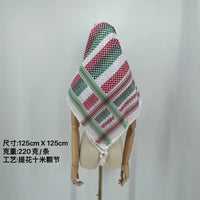What Makes the Traditional Scarves or Keffiyehs of the Arab World So Significant?
The Arab world boasts a vibrant textile heritage, with its rich traditions and diverse attire reflecting the unique cultural identities of its people. Among the most iconic pieces of clothing are the various types of keffiyehs, or scarves. These versatile and deeply symbolic garments have a long history and play a crucial role in expressing cultural pride and identity throughout the region.
Let's take a closer look at these captivating head coverings, discovering the distinct features, patterns, and significance that make each type of keffiyeh or scarf a true testament to the Arab world's textile prowess.

The Palestinian Keffiyeh: A Symbol of Resilience and Unity

The Palestinian keffiyeh is a deeply symbolic and iconic headscarf that holds immense cultural and political significance in the Palestinian territories and beyond. Its classic black and white checkered pattern, featuring square-shaped motifs and intricate designs like fishnet and olive branch patterns, is instantly recognizable. The keffiyeh is not just a piece of clothing; it embodies the enduring resilience, unity, and national identity of the Palestinian people. It serves as a tangible reminder of their historical journey and ongoing struggle for justice, freedom, and statehood. Today, the Palestinian keffiyeh is worn with pride, symbolizing solidarity and the preservation of cultural heritage in the face of adversity.
The Egyptian Shemagh of Sinai: A Vibrant Reflection of the Peninsula's Culture

The Sinai shemagh is known for its smaller, intricately woven checkered patterns, featuring a multitude of vibrant colors that reflect the diverse and rich culture of the Sinai peninsula. The checks in the design are typically smaller compared to other keffiyehs, creating a complex interplay of colors and shapes that contribute to its striking appearance. While it may be mistaken for the Palestinian keffiyeh when made in black and white, the Sinai shemagh maintains its own unique charm and cultural significance.
The Jordanian Shemagh: A Practical and Cultural Icon

The Jordanian shemagh, or "shmagh," is a distinctive and culturally significant head covering worn predominantly in Jordan and by Bedouin communities. Characterized by its intricate checkered pattern, it typically features a classic red and white design. This versatile garment serves as both a practical shield against the harsh desert climate and a symbol of cultural identity. The Jordanian shemagh is well-known for its finely detailed grid design and often includes decorative haddab, or tassels, that hang from its edges, adding an extra layer of cultural significance and aesthetic appeal. Made from soft and lightweight cotton, it is comfortable for everyday wear and a nod to Jordan's rich heritage. Beyond its traditional use, the Jordanian shemagh has also found its place in the world of fashion.
The Saudi Ghutrah: A Traditional and Practical Accessory

The Saudi shemagh, also known as the "ghutrah," is a traditional head covering commonly worn by the people of Saudi Arabia. It features a distinctive checkered pattern with red and white or black and white squares, which vary in size and design depending on the region. This versatile garment serves practical purposes, offering protection from the desert sun and sandstorms, while also serving as a cultural symbol of identity and heritage. The Saudi shemagh is an iconic accessory that holds a special place in Saudi culture and is often worn with pride to express one's connection to the rich traditions and history of the Kingdom of Saudi Arabia.





